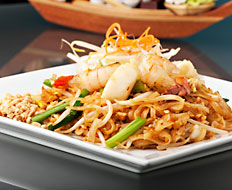What are you craving, exactly, when you yearn for a heaping mound of pad thai noodles, or a plate of kung pao chicken, or a bowl of miso soup?
On one very obvious level, it’s undoubtedly the taste. In the former two examples, the blend of sweet, savory, and spicy flavors offers a pleasing complexity quite unlike anything native to Western cuisines. And most diners would probably characterize miso soup as a savory, comforting dish that makes for an excellent prelude to a Japanese-style meal.
But beyond the flavors we typically talk about, there is an X factor at work in Asian cuisines. It’s a phenomenon that contributes in no small measure to our deep enjoyment of everything from Vietnamese pho to Korean kimchi to Chinese vegetables stir fried in soy sauce.
That X factor, which is receiving more than its share of attention in the culinary world these days, is umami, or the so-called fifth taste. It’s not sweet, bitter, or sour, exactly, and it’s more than simply savory. Umami is best characterized as a deeply pleasurable sensation of fullness in the mouth.
Reputedly discovered and named by the 19th century Japanese chemist Kikunae Ikeda, umami is primarily the product of glutamate molecules breaking down, typically through processes such as cooking, fermenting, and aging. The result is a taste and mouthfeel you’ve probably thought to describe not as umami, but as delicious.
Plenty of well-known staples of the Western pantry, including meats, mushrooms, tomatoes, anchovies, and parmesan cheese, have a high umami quotient. But Asian cuisines are positively teeming with umami-imparting ingredients, like soy sauces, fish sauces, beef stock, kimchi, pork, seaweed, fermented red pepper paste … the succulent list goes on.
All of which is to say that your hankering for signature Asian dishes may have roots in umami, in addition to the flavors you already experience on a more conscious level.
While high-end restaurants in hip neighborhoods have been deploying high-umami foods to great effect for some time, a heightened awareness of the incredible depth umami brings to dishes is trickling down to slightly more pedestrian settings.
At Umami Burger’s multiple Los Angeles locations, the namesake sandwich is topped with shiitake mushrooms, caramelized onions, roasted tomatoes, parmesan crisps, and umami ketchup. And the chain’s aptly named Earth Burger makes up for its lack of umami-rich ground beef with a mushroom-and-edamame patty, white soy aioli, truffled ricotta cheese, onions, and roasted tomatoes.
But burger outfits aren’t the only quick-serve or fast-casual subsegments that can take a cue from the great Asian culinary traditions and inject umami and other signature Asian elements into familiar fare. Take a look at the incredible range of novel Asian-fusion dishes and concepts that are turning up everywhere from suburban strip malls to roving food trucks these days.
In Los Angeles, the Jogasaki Sushi Burrito truck is making the rounds with its enormously popular hybrid. One menu item boasts shredded imitation crab, spicy tuna, avocado, cucumber, and rice, all wrapped either in a flour tortilla or in soy paper.
Traversing many of the same routes is Kogi, a relative veteran on the L.A. food truck scene, with its Korean tacos filled with short ribs, spicy pork, chicken, or tofu, as well as kimchi quesadillas and other crafty fusion fare.
Several small chains have been inspired to place Chinese steamed bao at the center of their concepts and to fill these toothsome steamed buns with a number of unusual ethnic fillings. Several selections rank high on the umami index.
At Take A Bao in Los Angeles, the menu includes not just soy grilled tofu bao (which seems intuitive enough) but also left-of-center varieties such as panko-crusted fish-filet and duck-confit bao.
The Dump Truck in Portland, Oregon, does for dumplings what Take A Bao and its ilk have done for steamed buns. The results, by most counts, are quite extraordinary. Think: bacon-cheeseburger dumplings; dumplings with (umami-rich) portobello mushrooms, rice noodles, and ginger; or pork, ginger, and scallion variations.
Meanwhile, in a different and decidedly novel take on what fusion can be, David Chang, founder of the Momofuku restaurant empire, devoted part of the inaugural edition of his Lucky Peach magazine to recipes that reimagined instant ramen noodles in a series of unlikely multicultural contexts. He included Instant Ramen Fideos with shellfish and chorizo, and Instant Ramen Gnocchi Parisienne, in which the noodles were puréed with milk and eggs to make a gnocchi dough.
This blending of the comfortable and familiar with the novel and unprecedented is a great way for quick-serve and fast-casual chains to incorporate elements of popular Asian fare into their existing menu schemes.
While not every hybrid will be a surefire success, menu pros who tap the potential of a fifth flavor and engage in a little creative cross-cultural experimentation may just find themselves with some promising new menu innovations.












